While many full season soybean fields are past the growth stage of spraying a fungicide (R6), later planted soybean may still benefit from a fungicide application.
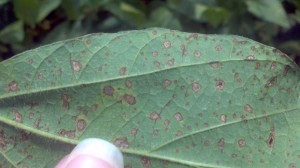
As I have mentioned in previous articles the amount and severity of a disease and effect on yield are closely associated with environmental conditions, management practices, growth stage and susceptibility of soybean variety planted. The main diseases that have been reported in Tennessee this season include frogeye leaf spot (FLS) and sudden death syndrome (SDS). FLS is caused by a fungus, Cercospora sojina, and creates tan to grey circular to angular lesions, with a dark brown to purple margin (Picture 1). Symptoms can be confused with chemical injury – read previous article for more info, Distinguishing Frogeye Leaf Spot from Chemical Injury in Soybean. The spores of the fungus survive in soybean debris and are wind and rain splash dispersed. Optimum conditions for disease infection include high humidity (>90%) and temperatures between 77 and 86 °F, though disease can develop outside of these conditions. A timely fungicide during soybean reproductive stages (usually R3, pod development) can protect yield loss from this disease. I have on-going research projects to better define the economic disease threshold to better guide fungicide applications in the future.
SDS is also caused by a fungus, Fusarium solani f. sp. glycines, but it is in the soil and infects the roots of soybeanplants earlier in the season. The fungus produces a toxin that is translocated to the leaves resulting in scattered, interveinal cholorotic (yellow) spots
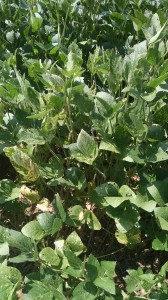
(Picture 2). These spots may become necrotic (brown, dead tissue) (Picture 3). A foliar fungicide will NOT control SDS. Management options for SDS include cultural practices (rotation, improving drainage, etc.), variety selection and new fungicide seed treatments have begun to show control of the disease, mainly ILeVo fungicide seed treatment (active ingredient fluopyram) by Bayer, which is anticipated to be available for the 2015 growing season. For more information on SDS read the previous article, Sudden Death Syndrome (SDS) in Soybean. Symptoms of SDS can look similar to stem
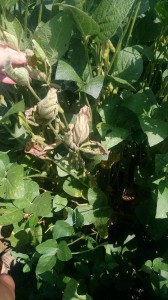
canker and triazole or surfactant injury. An easy way to determine if you are dealing with chemical injury or a disease is to look at the newest growth on the plant (upper most leaves), if these leaves are symptomless then you are most likely dealing with chemical injury. If the upper, newest leaves are also showing symptoms you are most likely dealing with a disease (Picture 4, new growth with SDS symptoms). There are nutrition deficiencies and other disorders that can look like disease, for more information on issues that have been reported this season read Dr. Angela McClure’s article on Yellow Tops in Soybean.
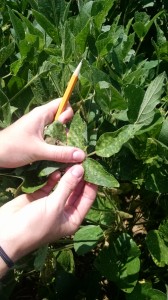
Other diseases that can be found this season include Septoria brown spot, target spot, and stem canker. Soybean rust has not been found in Tennessee, and the furthest north it has been reported is in Prattville, AL, just northwest of Montgomery. Septoria brown spot (Picture 5) and target spot (Picture 6) do not usually pose a great threat to yield, although some varieties can be more susceptible than others. Stem canker symptoms can look very similar to SDS, although there will usually be a lesion on one side of the stem (Picture 7). One can also split the stem and look at the center pith – if SDS the center pith would still be white, while it will be brown if stem canker (Picture 8). Although if Dectes stem borer has gotten into the plant the center pith will be brown (Picture 9) and cannot be used to determine the disease. While stem canker is usually more prevalent during hot, dry years and SDS favors cool, wet years, I have found small areas of stem canker out in my research plots this year; although much more SDS is present this year than stem canker. Similar to SDS, stem canker cannot be controlled with a foliar fungicide, only variety selection and rotation will help manage it. More information on soybean diseases can be found at UTcrops.com (Soybean Disease and Nematode Identification Field Guide) as well as a foliar fungicide efficacy table (Soybean Fungicide Efficacy Table). This winter a soybean fungicide seed treatment efficacy table will be finalized and available on the UTcrops.com website.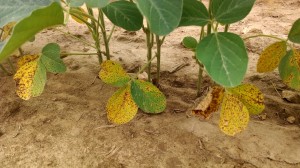
Picture 5. Septoria brown spot
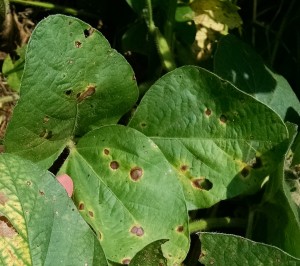
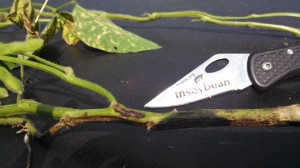
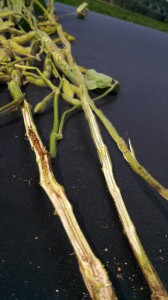
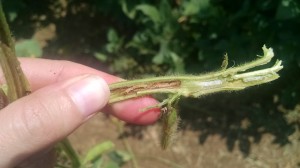


Good review. You’re doing a great job of filling Melvin’s shoes.
I planted AG 4531 around 5/21 for seed production. The seed was treated with ApronMax and planted on 15″ rows at 145K seeds per acre. At R3, Stratego YLD was applied at 4 oz per acre. Last week the FLS pressure was so noticeable that we considered spraying a fungicide for the second time. We did not pull the trigger because the beans were at R5.5.
I do not know if this is evidence of fungicide resistance or not. My guess is with all of the rain and mild weather this summer, we have had perfect conditions for FLS development for an extended period of time.
Looking at the fungicide efficacy table, it did not seem to be a lot of difference between Stratego YLD and Quadris Top when it came to FLS.
I grow irrigated beans and that is where I usually see SDS. Is the ILeVo seed treatment by Bayer so much better than it’s competitors on SDS that it would be worth my money to intentionally treat the soybean seed that will be irrigated with this product?
Richard,
In response to your first comment about frogeye leaf spot (FLS), the only way to know for sure if there is fungicide resistance in the pathogen population is to test it. Due to the Tennessee Soybean Promotion board funding, we are testing FLS for QoI/Strobilurin fungicide resistance for free at the West Tennessee Research and Education Center, more information on how to sample and send FLS infected leaves for testing can be found under ‘Diseases & Nematodes’ under ‘Soybean’ on UTcrops.com (copy and paste the address listed at end of response for directions and sampling form that should be sent in with sample). Other things that can affect the efficacy of a fungicide are: amount of water used (recommended 5 gallons per acre (gpa) for aerial applications, at least 15 gpa for ground application), coverage (nozzle type and angle, pressure, droplet size, etc.), and how long after application rain or irrigation event occurred.
In response to your second comment about sudden death syndrome (SDS) and use of ILeVO – this is the first chemical that many university researchers recognize as having efficacy on the SDS pathogen. In Tennessee, this is the first year I am testing it in an SDS inoculated field and will present results during winter county production meetings, but considering the data I’ve seen from other university researchers if you are wanting to manage SDS with a seed treatment ILeVO is the top and really only choice on the market right now to do so. I don’t know what the cost of the seed treatment will be or the price of soybean you will get, or the extend of yield loss you have incurred from SDS in the field in question, which will all need to be considered to determine if it will be economically sound for you. Other things to also consider – SDS will be more severe in fields with soybean cyst nematodes (SCN) (links on sampling SCN and form for testing soil are listed below), in fields planted early, and in years that have cool and wet conditions.
QoI/Strobilurin fungicide resistance testing of FLS instructions and form: http://utcrops.com/soybean/diseases/disease_images/Directions%20for%20taking%20Frogeye%20Leaf%20Spot%20samples_updated.pdf
Info on how to sample for SCN:
http://utcrops.com/soybean/diseases/disease_images/Nematode%20Sampling%20How%20to%2020121.pdf
Testing form for SCN:
http://utcrops.com/soybean/diseases/disease_images/738-Nematode%20Sample%20Form-REVISED%2010-12-12.pdf
Thanks for your comments and questions.
Best Regards,
Heather